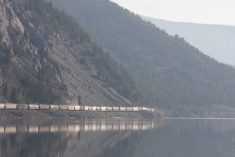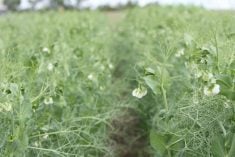WASHINGTON, D.C. – The billions of dollars in bailouts the United States Congress has sent to American farmers since 1998 have added insult to injury on Dan Specht’s farm.
Specht grows organic crops and raises grass-fed beef on 700 acres in northeastern Iowa, 280 acres of which he owns.
Because he diversified in the 1980s, he has been ineligible for most of the largesse made available through the 1996 Freedom to Farm program.
The direct “transition” payments are based on eight major crops farmers grew on land they owned in the early 1990s.
Read Also

Prairies have variable soil moisture conditions
The dry weather in the west was welcome for preserving grain quality and advancing harvest, but it has resulted in very dry soil moisture conditions.
Only farmers who receive transition payments can tap into marketing loans, which have supported farm income through the price trough that started in 1998.
And emergency payments made in 1998, 1999 and 2000 were based on the transition payments too.
At hearings in March, Specht told the U.S. Senate agriculture committee that the programs have also contributed to overproduction, further depressing prices he receives for his crops.
He is part of growing calls for a fundamental shift in how the U.S. government supports farmers: a shift to paying them for the environmental benefits they bring to the nation rather than for the crops they grow.
“I think the consumer would get more out of it,” Specht testified.
It would be a radical change in support, akin to European “multifunctionality” payments.
While the concept won’t likely be central to the 2002 U.S. farm bill, some believe multifunctionality waits in the wings.
“We need a different view on how we can reach out and help our farmers and ranchers,” said Democratic senator Tom Harkin of Iowa, a proponent of “green payments” for conservation programs on farms.
He notes the U.S. government spent $1.9 billion (US) on conservation programs in 2000, compared to $32 billion on agriculture in total.
“(Conservation) is a commodity we have to invest in now for future generations,” he said.
To date, Senate debate on the 2002 farm bill has focused on the changing structure of U.S. agriculture.
Republican senator Dick Lugar of Indiana frequently quotes a Sparks Companies study showing that the 157,000 largest farms in the nation produce 72 percent of commodities.
At the other end of the spectrum, 82 percent, or 1.57 million farms, produce only 13 percent of commodities.
The larger the farm, the more likely it receives government payments.
“We have a lot of people in this country who have never made as much money as they have in the past two years,” Democratic senator Collin Peterson of Minnesota told a canola conference in March.
According to the U.S. Department of Agriculture’s economic research service, 42 percent of farmers received government payments in 1999, up from 36 percent in 1998.
The gross income of those farmers who fell through the safety net was less than half that of farmers who received payments.
Most farms rely on off-farm income to survive. In 2000, this income averaged $60,000. Average farm household income is about one-third higher than the U.S. household average, according to the ERS.
Economist J.B. Penn, author of the Sparks study oft-quoted by Lugar, has said the marketing loans program has guaranteed prices to large farmers that are well above their costs of production.
These farmers tend to achieve higher yields and have lower costs, he said. They obtain higher-than-average prices because they have better marketing skills.
“All the extra payments we’ve seen are simply the icing on the cake,” he said.
More revenue means they can increase production, add to stocks, and put more pressure on already depressed prices.
They can also afford to bid up land values and buy out struggling smaller neighbors who don’t benefit from farm programs, Penn said.
Penn, who recently was put in charge of farm programs by the U.S. government, has argued the country needs a “rural development” policy separate from what it offers to commercial producers.
Some economists and environmentalists suggest conservation payments would achieve this goal.
Argument against
But commodity groups oppose a wholesale shift toward conservation payments. And they don’t like the idea of targeting payments to small farmers or those who grow nontraditional crops.
Wayne Hammon of the National Association of Wheat Growers said the farm bill should remain as help for farmers who grow major crops.
“These are the people who produce the food for the country and these are the people we should target,” he said.
“We don’t need to build a safety net for all the experiments.”
Farmers also wonder how government will define a small farm.
At a recent conference, Karen Watt explained her 250-acre family-run fruit farm is small in area, yet grosses over $1 million.
She said she doesn’t want to be left out of farm programs that are geared to traditional grains and oilseeds.
On the other hand, Tom Borgen notes family farms in his state of North Dakota are often 2,000 to 3,000 acres, and shouldn’t be left out of programs targeted to small producers.
“They think we’re a corporate farm,” he said.














